�
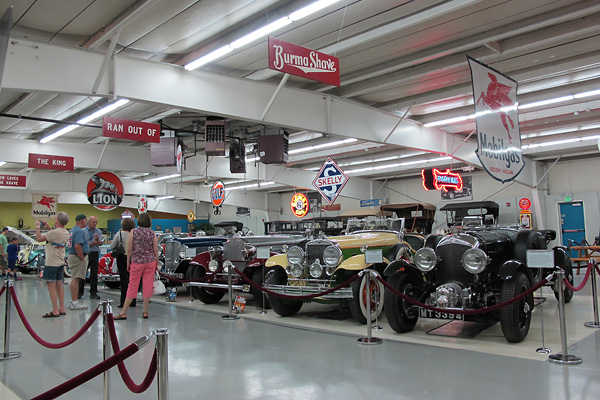
�
�
BritishV8 Tours: The Cussler Museum in Arvada Colorado
��
�
words and photos by Curtis Jacobson�
�
Author Clive Cussler Shares His Passion for Adventurous Motoring
��
BritishV8 enthusiasts recently visited The Cussler Museum of fine automobiles in Arvada, Colorado.�
Our tour was one of the exciting outings and activities that comprised our eighteenth annual meeting.�
The Cussler Museum displays over one hundred cars collected by popular novelist Clive Cussler, best known�
for adventure genre bestsellers such as Deep Six, Black Wind, Sahara, and Raise the Titanic.�
Cussler's cars appear in these and other "Dirk Pitt" novels and feature film adaptations, and often�
grace his book cover jackets too.�
The Cussler Museum is open from 10am to 7pm on most Mondays and Tuesdays between April and September.�
Admission costs just five dollars per person. (Phone 303-420-2795 for further details.)�
Some favorite photos from our tour are featured below.�
�
Tip: Start in the Back Room!
� �
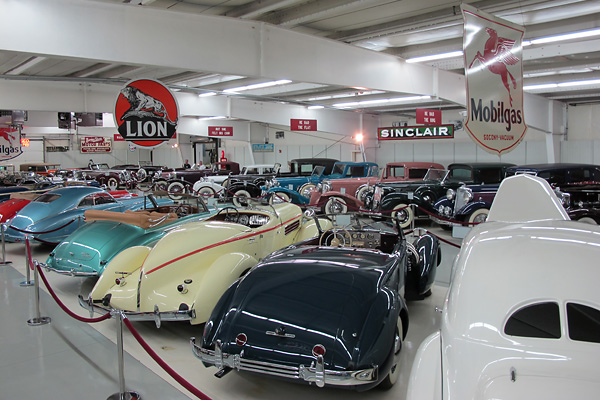
�
The Cussler Museum spans just two large rooms. For the most part, its back room features cars built
�
before World War 2 including particularly excellent assortments of boattail speedsters and classic
�
town cars. Many of these cars feature custom, coachbuilt bodies. These cars look stunning, even
�
while displayed behind velvet ropes. The front room features post-war cars up to about 1965.
�
Most of the post-war cars are convertible variants of mass-market American sedans.
�
Brass Era
��
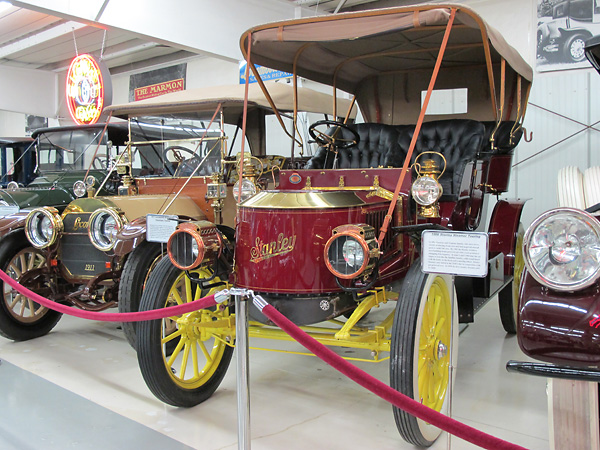
�
1906 Stanley Steamer Touring
�
Identical twins Freelan Oscar and Francis Edgar Stanley built a car, went racing, and found fame. In
�
1906, they exceeded 127mph at Daytona Beach! The brothers sold their original design to Locomobile,
�
then initiated production of a different and improved model. Stanley touring cars could reach 75mph.
�
About 11,000 were built. Generally, Stanley Steamers burnt kerosene though gasoline from a separate
�
tank supplied a pilot burner. Water tanks needed to be topped up about every 45 miles.
�
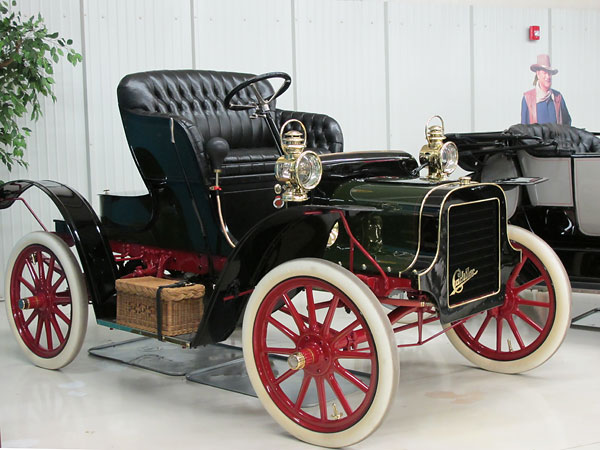
�
1908 Cadillac Model S Tulip Roadster
�
Cadillac's slogan "Standard of the World" dates to 1907, and refers to the fact that their cars
�
featured standardized parts that could be assembled and used without skilled fitment. This car's
�
10hp engine has a single cylinder and displaces 98.2 cubic inches. By 1907, that minimal engine
�
was starting to hurt sales, and Cadillac would soon join the trend to multi-cylinder engines.�
�
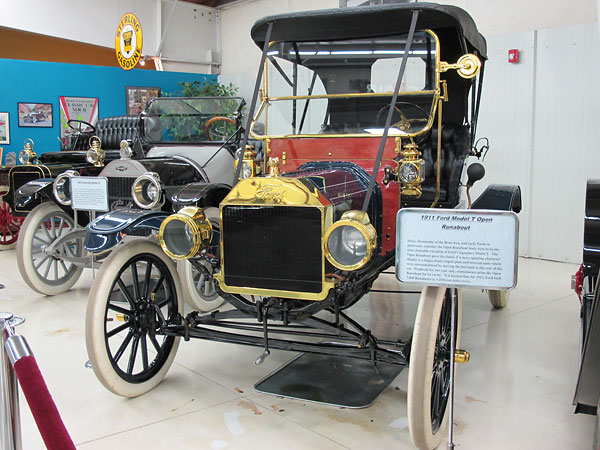
�
1911 Ford Model T Open Runabout
�
Open Runabouts were produced for just one year and they're particularly collectable because they
�
have a longer hood, sloped windscreen, lower seating position, and they're rare. It's hard for me
�
to call them sporty, but they were relatively light and their four cylinder engines did displace 177
�
cubic inches. Dark blue was Ford's standard color in 1911; Henry Ford hadn't settled on black yet.
�
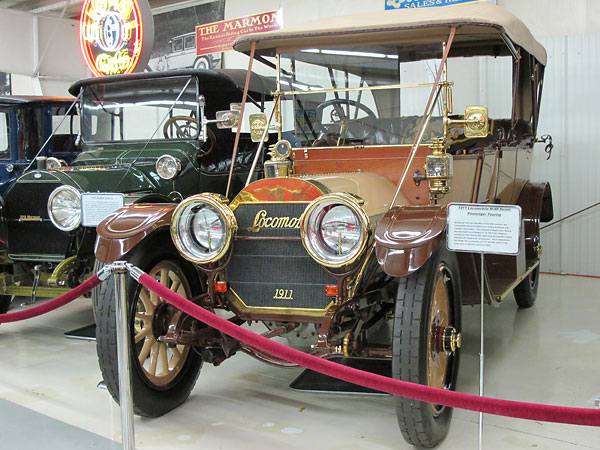
�
1911 Locomobile M48
�
In contrast with Ford, Locomobile occupied the very top tier of the American market.
�
In 1911 Locomobile introduced their new 525 cubic inch, T-head, six-cylinder engine.
�
It reportedly produced about forty-eight horsepower. Original price? $4800.
�
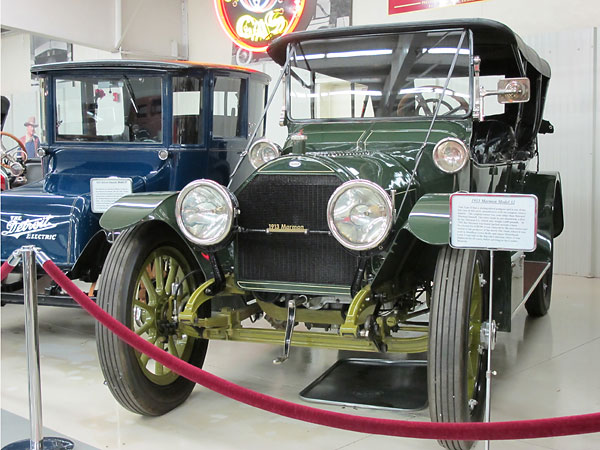
�
1913 Marmon Model 32
�
Marmon is credited with innovation in use of aluminum, and this particular Marmon has a cast
�
aluminum body. Curb weight is 2600 pounds. Next factoid: the first known use of a rear view
�
mirror on a car was on Ray Harroun's Marmon at the inaugural (1911) Indianapolis 500.
�
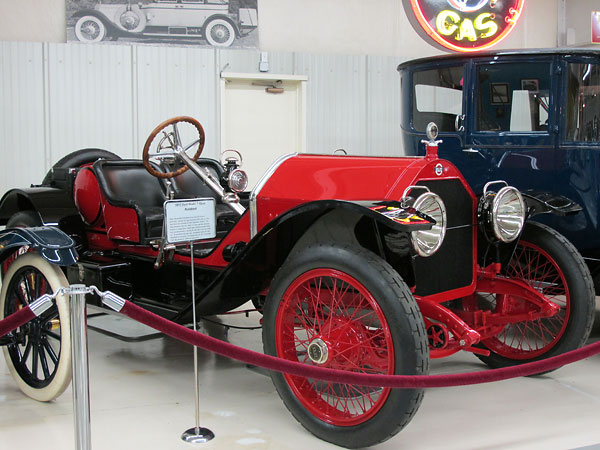
�
1913 Stutz Bearcat Series 4B
�
A Stutz placed 11th in the inaugural Indy 500, which was quite good considering the displacement
�
and preparation level of rivals. The following year, Stutz announced their new "Bear Cat" (two words
�
at the time) in the Indy 500 program with a slogan that soon became famous: "The Car that made
�
good in a day." It was a stripped down, short wheelbase model, built mainly from off-the-shelf parts.
�
A 390cid, 60hp, four cylinder engine was supplied by The Wisconsin Motor Company.
�
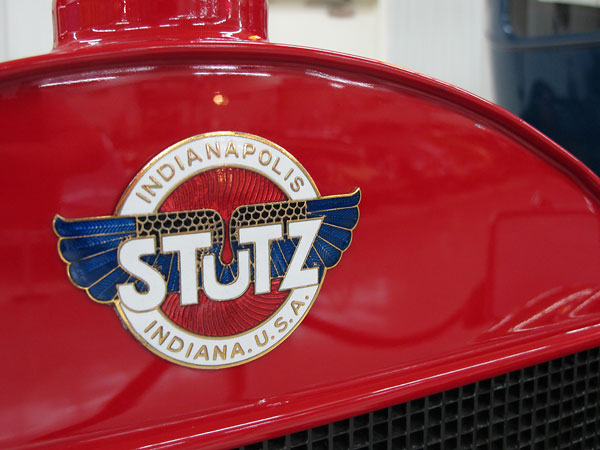
�
Badge: Stutz - Indianapolis, Indiana U.S.A.
�
In 1912, Stutz Bearcats won 25 of 30 races entered. In 1915, Erwin "Cannon Ball" Baker used a
�
Bearcat for his record coast-to-coast drive, which inspired the famous Cannonball Run rallies.
�
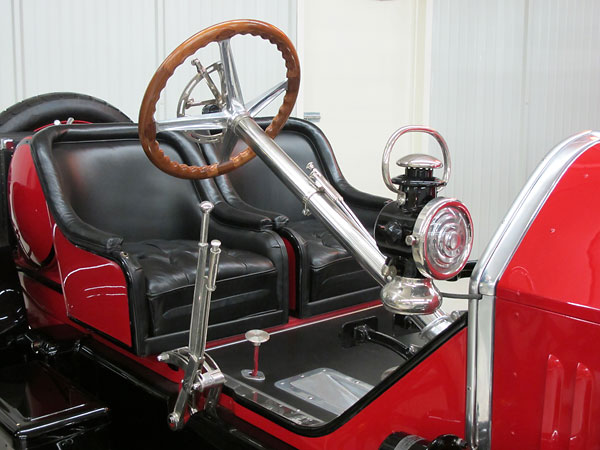
�
Stutz Bearcat's Stripped-Down but Top Quality Cockpit
�
A sportscar for the young and wealthy, Bearcats became the iconic car of America's Roaring Twenties.
�
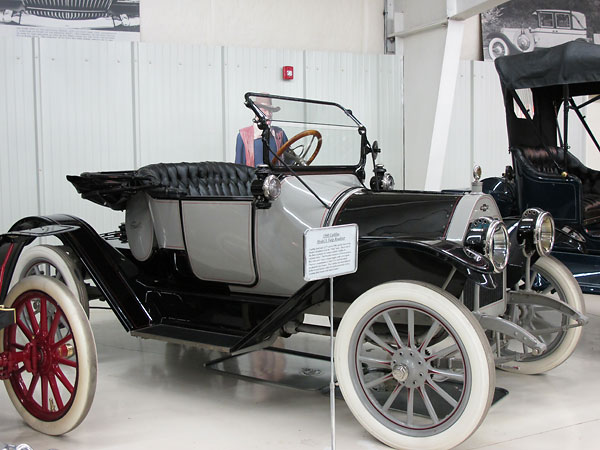
�
1914 Chevrolet Series H
�
General Motors founder W.C. Durant wanted to compete head-to-head with Ford's Model T. So,
�
in 1914, Chevrolet introduced this two-door "Royal Mail Roadster" and also a four-door
�
model called "Baby Grand". Their 171cid four-cylinder engines produced about 26hp.
�
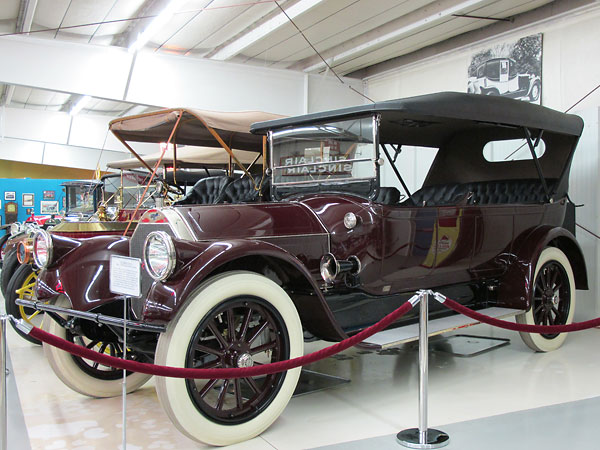
�
1916 Pierce Arrow Series 4 Model 48 Seven Passenger Touring
�
Peerless and Packard introduced new V8 and V12 engines in 1916, but Pierce remained committed
�
to refining their large-displacement six-cylinder engine design through 1927. This particular example
�
features a 525cid, 48hp version and a four-speed selective sliding-gear manual transmission. Trivia:
�
uncommonly quiet engines helped make Pierce-Arrow cars especially popular with bootleggers.�
�
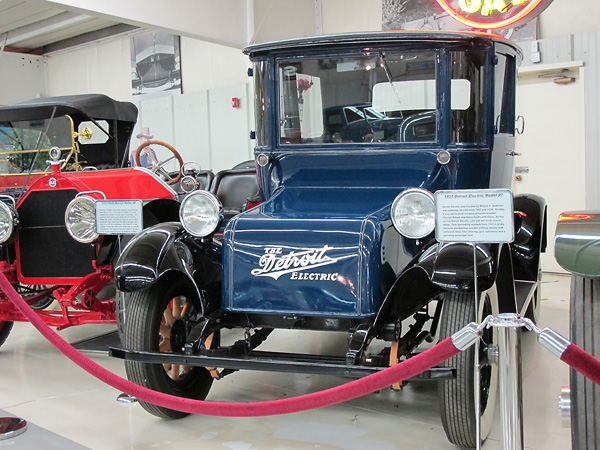
�
1931 Detroit Electric Model 97
�
As long as there have been cars, there have been electric cars. They remain "the future of
�
the automobile". Advantages: no hand-cranking, nearly silent, no tailpiple emissions. But
�
batteries degrade quickly, so range goes from short to shorter, and then they're expensive
�
to replace. The Detroit Electric car company had a particularly long run; they built electric
�
cars between 1907 and 1939. Their interior is the best part: with tiller steering from the back
�
seat, a swiveling front-mounted passenger seat, wrap around windows, and a flat floor.�
�
Michigan
��
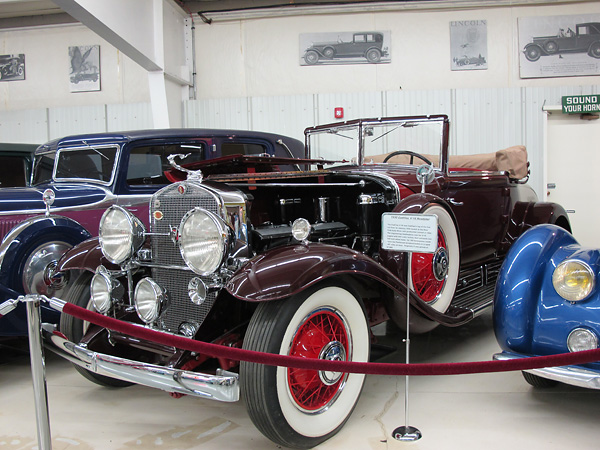
�
1930 Cadillac V16 Roadster
�
The Great Depression of the 1930s started with a crash at the New York Stock Exchange on a
�
Tuesday in October, 1929. Three months later, at the New York Auto Show, Cadillac launched
�
their "Sixteen" series to universal praise. All six body styles from opulent two-door roadster
�
right through lavish town car and limousine featured Cadillac's magnificent new V16 engine.
�
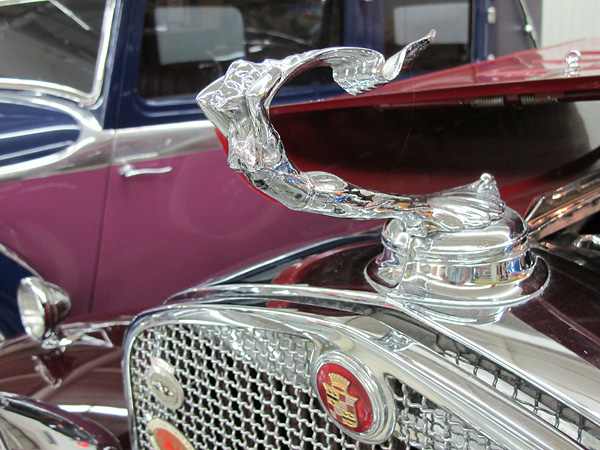
�
1930 Cadillac Hood Ornament
�
Remarkable styling, technical merit, and quality weren't enough to overcome the economic situation.
�
Though production of the Cadillac Sixteen range continued through ten years (with particularly
�
conspicuous updates for 1938), sales were only strong at the very start. Only 4076 Cadillac Sixteens
�
were produced. About half of them were built in the first six months of 1930.
�
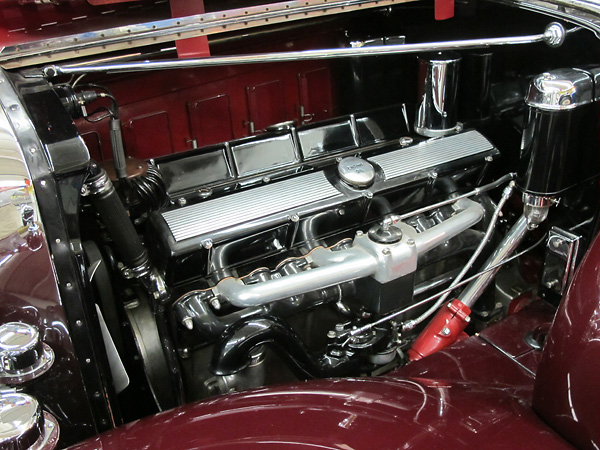
�
Cadillac Sixteen Engine
�
Cadillac's V16 engine's development had been a top secret project. The first V16 ever designed
�
from a clean sheet of paper, it had a 45-degree cylinder bank angle. Overhead-valve heads also
�
helped keep the engine narrow. Displacement totaled up to 452 cubic inches. It was rated 175bhp.
�
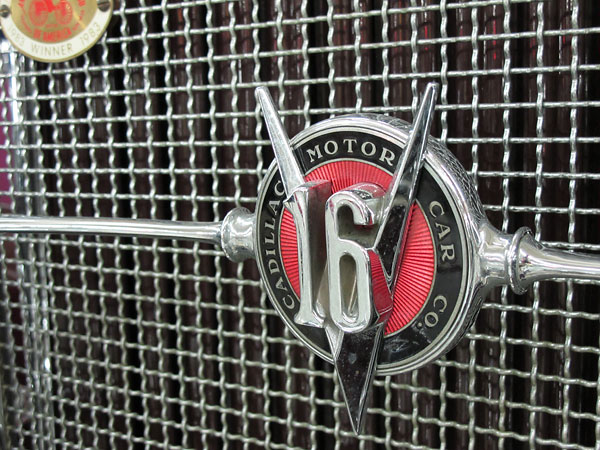
�
Grille Badge: V16 - Cadillac Motor Car Co.
�
Want one? A similar 1930 Cadillac V16 Roadster sold at auction on October 9, 2014 for $1,100,000.
�
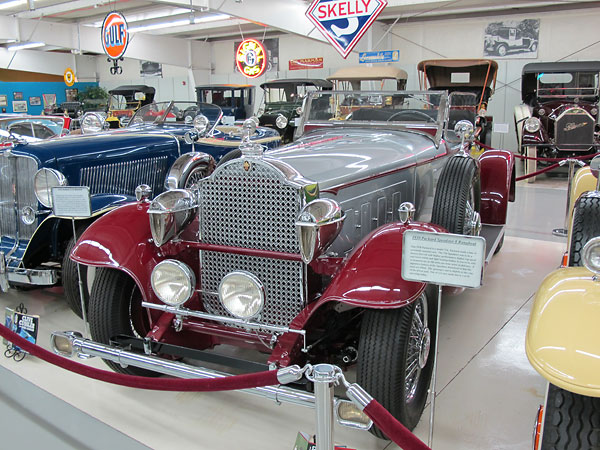
�
1930 Packard Model 734 Speedster 8 Runabout
�
As rivals sank, Packard Motor Car Company sailed through the Great Depression with colors flying.
�
Packard had long offered top-tier luxury and refinement. Though operating on a smaller scale than
�
Cadillac, Packard was also focused on growth in the "high performance" segment in 1930. They had
�
been building excellent 9-bearing straight-eight engines since 1923. For 1930's Model 734 series,
�
Packard particularly upgraded cylinder head and manifold designs. The uprated Packard 384cid
�
(6.3L) "Super 8" engine was rated 120bhp.
�
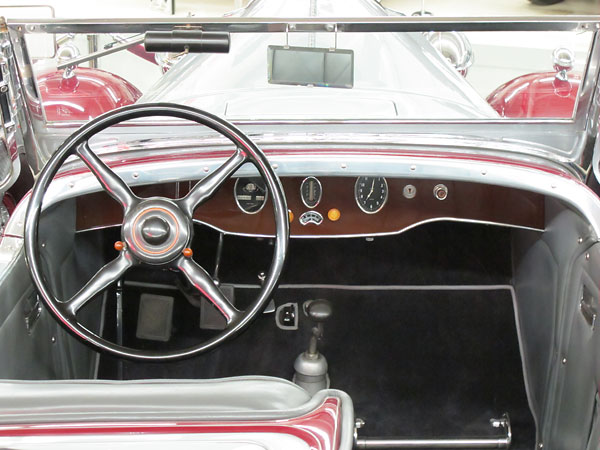
�
The Packard Speedster dashboard and steering wheel are both distinctive and elegant.
�
Far more unusual: the driver's seat is mounted ahead of the passenger seat to provide elbow room
�
for spirited driving. Note also the placement and short throw of the four-speed gearbox's selector.
�
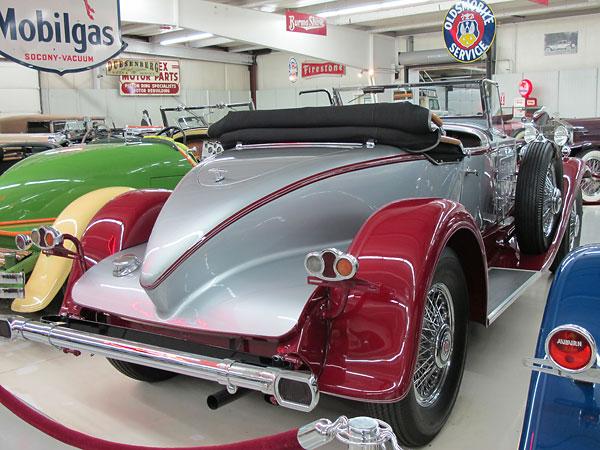
�
A 1930 Packard Model 734 Boattail Speedster sold at auction for $506,000 in 2011.
�
RM Auctions: "Packard offered the 734 Speedster with five different body styles. The Rumbleseat
�
Runabout, Phaeton and Boattail Runabout were priced at $5,200, while the Victoria and Sedan were
�
an even $6,000." Christie's Auctions: "113 Packard Model 734 Speedsters were built, of which 39
�
were designated Runabouts, as delineated by their 442 body numbers. Of those, just 11 are strongly
�
believed to exist today as complete cars."
�
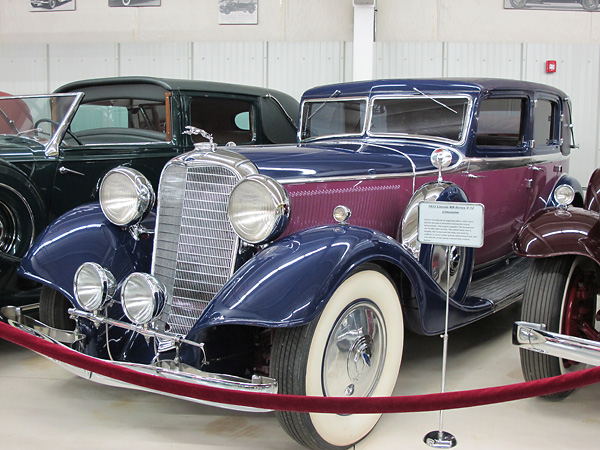
�
1933 Lincoln KB V12 Judkins-bodied Limousine
�
Lincoln introduced their Model K in 1930 with 385cid V8 engines. A new-design 448cid V12 engine was
�
introduced in 1932. "KA" and "KB" designations were used to indicate V8 and V12 respectively. In 1933,
�
the KA designation indicated a smaller (382cid) V12. In 1934, both models got 414cid V12 engines;
�
KA and KB indicated two different wheelbases that year. Go figure! Trivial fact: the factory that built
�
these big Lincoln luxury cars was located in Long Beach, California. Also, although most K-Series
�
Lincolns were assembled with Lincoln's own bodies, bare chassis were available and various builders
�
offered custom bodies. This particular example features a Judkins "two window" limousine body.
�
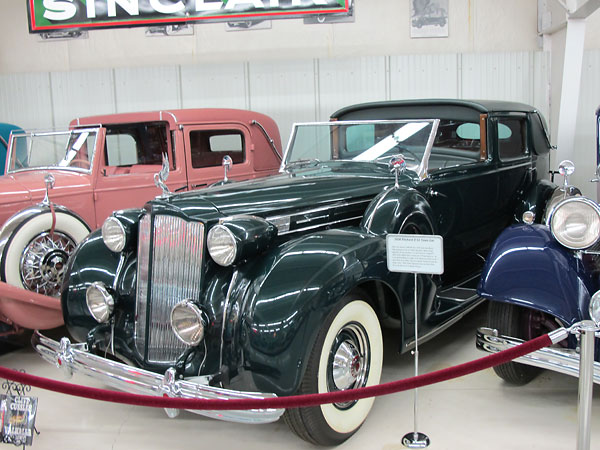
�
1938 Packard V12 Town Car (Model 1608)
�
Only limited documentation remains for this particular Packard. Its bodywork is believed to have been
�
a one-off project by a coachbuilder named Henry Brunn under contract to well-known Packard
�
dealer Earle C. Anthony of California. It has a 139 inch wheelbase, and its roofline is about
�
two inches lower than other Packard Town Cars of its age.
�
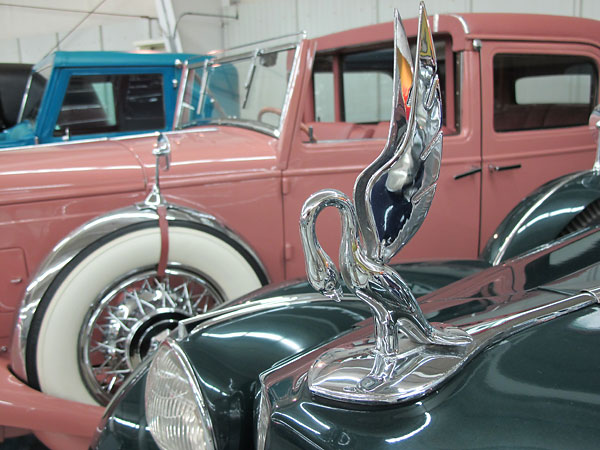
�
1938 Packard Hood Ornament
�
Packard had pioneered the V12 engine configuration with their famous "Twin Six" engines from 1916.
�
In 1932, Packard introduced an entirely new and sublimely smooth 7.3L V12. At introduction these
�
engines were rated 160bhp, but they evolved to 473cid (7.7L) and 202bhp ratings before production
�
ended in 1939. This 1938 Packard has a 473 cubic inch engine, rated 175hp.
�
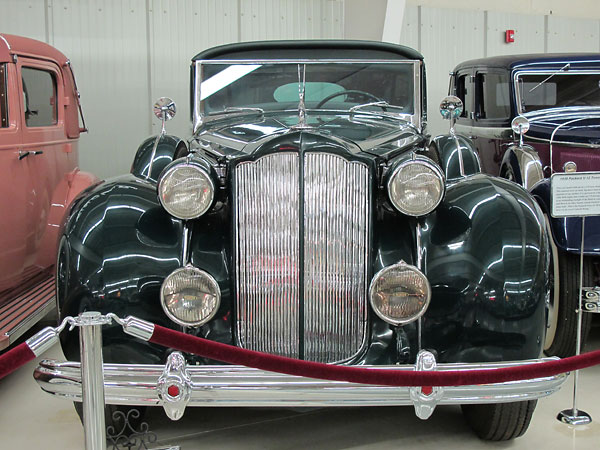
�
1938 Packard Waterfall Grille
�
"Waterfall grille" has been used to describe many cars, but never more accurately than here.
�
Packard survived the worst of the Depression, 1933 and 1934, with total sales of only 15,000 cars.
�
The company invested boldly, developing a "Junior" six-cylinder model range and tooling up a whole
�
new factory to produce it. Sales rebounded: 37,653 in 1935, 68,772 in 1936, and 95,455 in 1937.
�
But trouble was coming. Economic storm clouds gathered through 1938 as war brewed in Europe.
�
Sales of V12 powered Packard dropped from a record 1,300 cars in 1937 to only 566 in 1938.
�
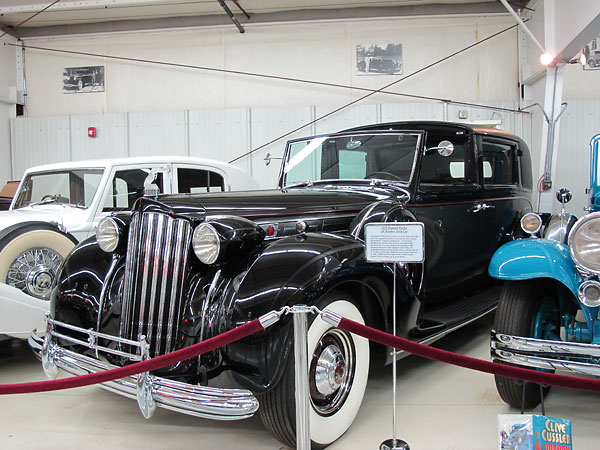
�
1939 Packard Twelve All Weather Town Car (Model 1708)
�
The luxury end of the car market suffered worst in the pre-war recession. 1939 was the final
�
year for Packard Twelve production, and this All Weather Town Car is one of the last
�
Packards fitted with handsome bespoke coachwork by The Rollson Company of New York,
�
a firm particularly associated with Packard town cars and limousines.
�
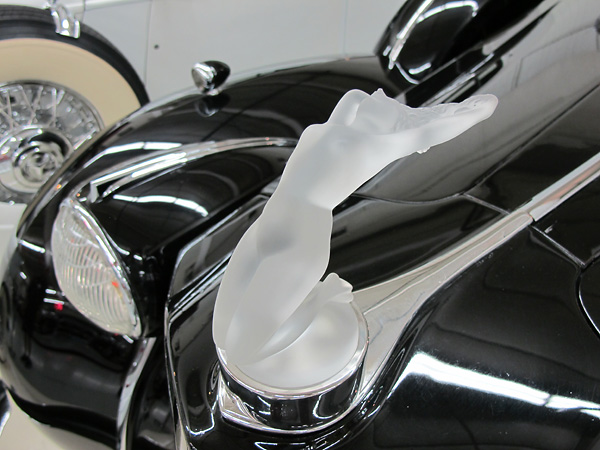
�
1939 Packard Chrysis Crystal Hood Ornament.
�
�
Indiana
��
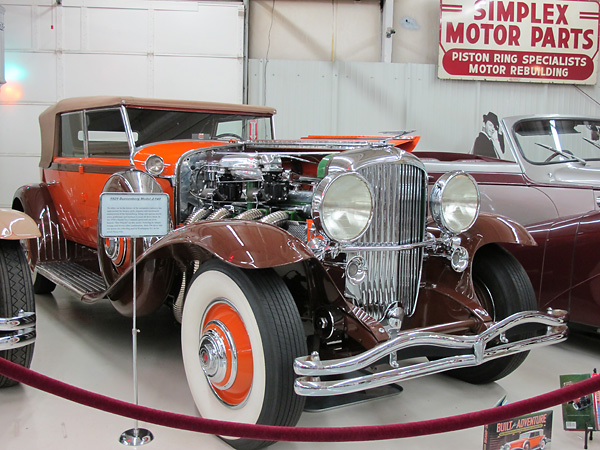
�
1929 Duesenberg Murphy-bodied SJ (J140)
�
Duesenberg Automobile & Motors Company was founded in 1913. In October 1926, Duesenberg was
�
acquired by Errett Lobban Cord to operate as a division of his Auburn Automobile Company. Cord
�
empowered Fred Duesenberg to develop a world-beating chassis. For the J-series chassis, Gordon
�
Buehrig designed body elements such as fenders, radiator grilles, hoods, and instrument panels.
�
Buehrig also designed bodies for Duesenberg affiliated branches, but these were "coachbuilt" cars:
�
bodies were added after cars left the Duesenberg factory. About half of J-series Duesenbergs were
�
styled by independent coachbuilders. This particular example features a body by Murphy Inc. of
�
Pasadena, complete with Murphy's trademark extra-narrow "clear vision" A and B pillars.
�
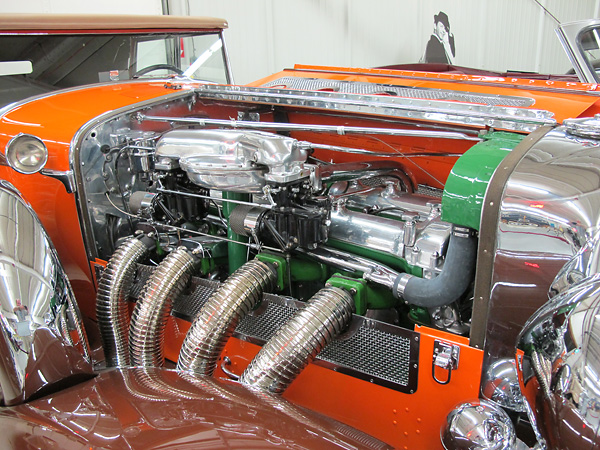
�
Duesenberg Supercharged DOHC Inline-8 Engine
�
Engine technology was what set Duesenbergs apart. Here we have a 1929 engine with dual overhead cams,
�
four valves per cylinder, and a compact supercharger! It produces about 280hp from 420 cubic inches.
�
The Duesenberg chassis, with four-wheel, servo-assisted hydraulic brakes, was also state of the art.
�
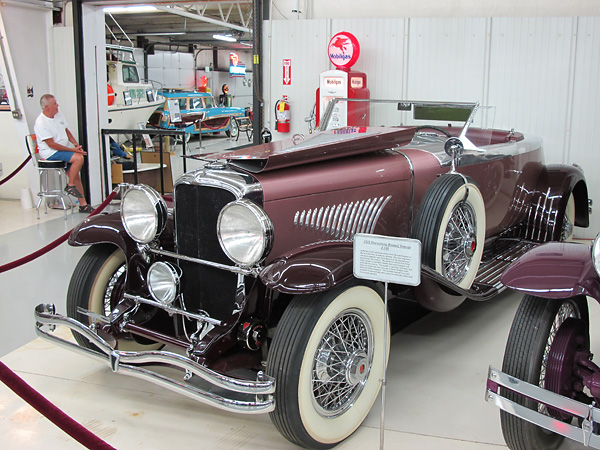
�
1929 Duesenberg Murphy-bodied Boattail Torpedo (J198)
�
Lithe and graceful, Murphy bodies were very popular with Hollywood stars.
�
One of just six built with a "Torpedo" boattail, this car is extra special.
�
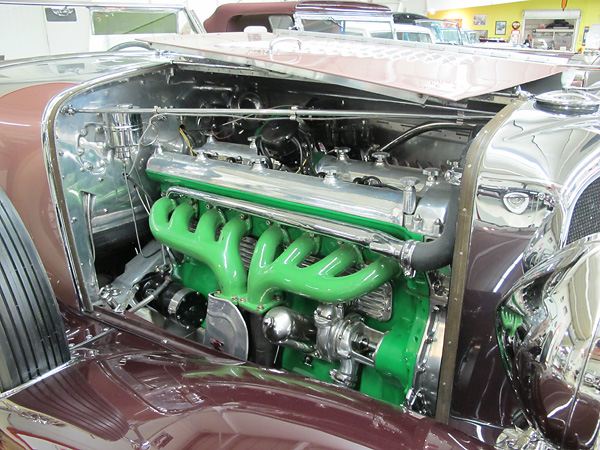
�
Duesenberg J-Series DOHC Inline-8 Engine
�
Even without supercharger, the Duesenberg 420cid inline-8 was rated 265 horsepower.
�
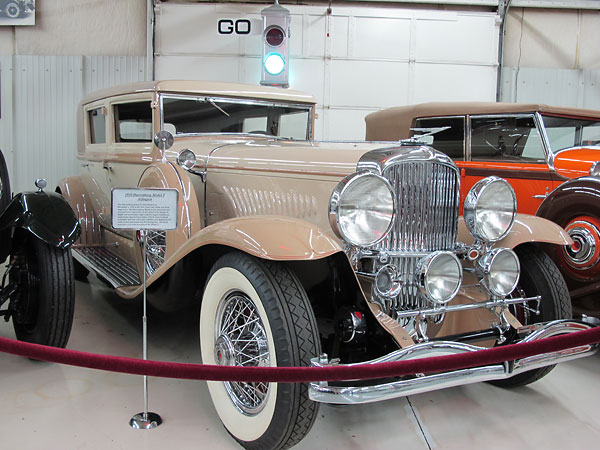
�
1930 Duesenberg Derham-bodied Arlington Club Sedan (J232)
�
The Derham Body Company was famous for especially beautiful and luxurious sedan bodies
�
and interiors. This car features a one-off design Derham called "Arlington Club", atop a
�
153.5" chassis. Duesenberg priced their J-series chassis from $8500. I don't know what
�
Derham charged for their coachwork, but it could easily have equaled that figure. Clive
�
Cussler did quite well to purchase this car for just $506,000 at public auction in 2010.
�
�
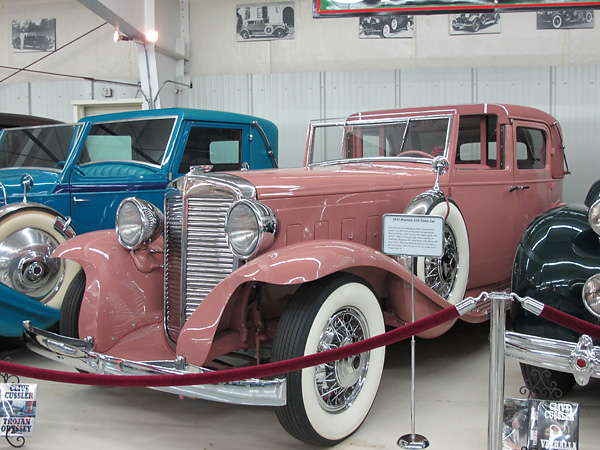
�
1931 Marmon Sixteen Town Car
�
Howard Marmon began designing his V16 engine in 1927, but production was delayed until 1931. By
�
that time, Cadillac had stolen Marmon's glory. By some accounts, Marmon had a superior engine.
�
Whereas Cadillac's engine block was iron, Marmon used steel sleeves within an aluminum block to
�
save weight. The Marmon displaced 491cid to Cadillac's 452, and had a higher compression ratio too.
�
Only 392 Sixteens were built before the company collapsed. The Marmon Registry says 95 still exist.
�
Clive Cussler's is the rarest of the rare: the only Marmon Sixteen Town Car ever built.
�
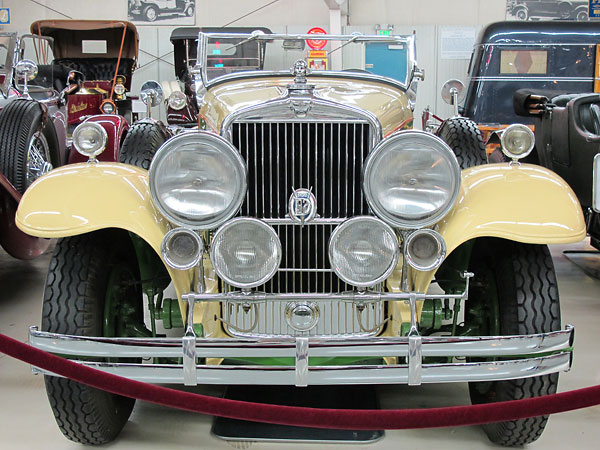
�
1931 Stutz DV-32 Speedster
�
Since 1928, Stutz's Vertical Eight had featured an overhead cam straight-8 engine in a double
�
drop chassis of unusual rigidity and low CG. For 1931, Stutz substantially improved the engine
�
with dual overhead camshafts and four valves per cylinder. The result was remarkable: power
�
increased from 113bhp to 156bhp. Torque rose to 300ftlbs. However, performance upgrades
�
weren't enough to improve sales. 1931 production added up to just 384 cars.
�
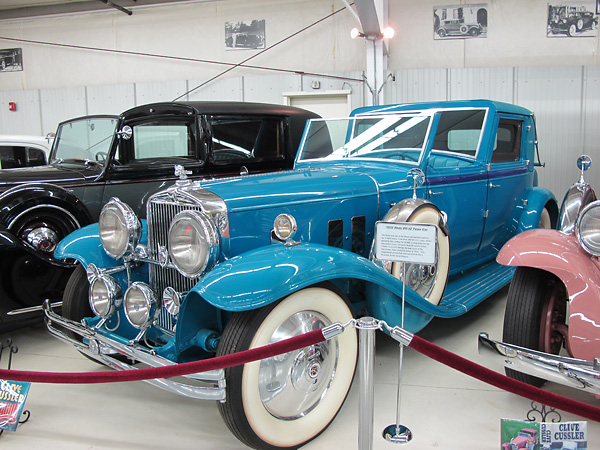
�
1932 Stutz DV-32 Town Car
�
Stutz continued to offer remarkable cars, but only managed to sell about 120 in 1932.
�
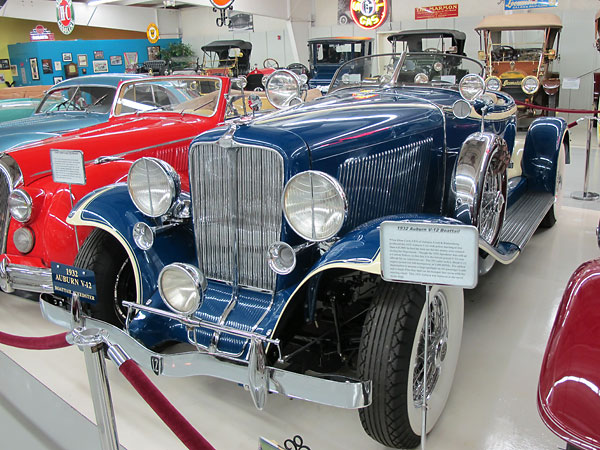
�
1932 Auburn V12 Boattail
�
Al Leamy styled Auburn's 1931 Boattail Speedster in modern Art Deco style. The design carried
�
over to 1932 when Auburn began offering a George Kublin designed Lycoming-sourced V12 engine
�
featuring 45 degree V and overhead cams working horizontal valves. This V12 produced about
�
160hp from 391 cubic inches. The V12 was a technical success, but only about 2,250 were built
�
(for six different body models) over 2.5 years. The V12 was dropped in 1934. Inline-8 equipped
�
Auburn boattails sell for about $250,000 today, while V12s typically command twice that price.
�
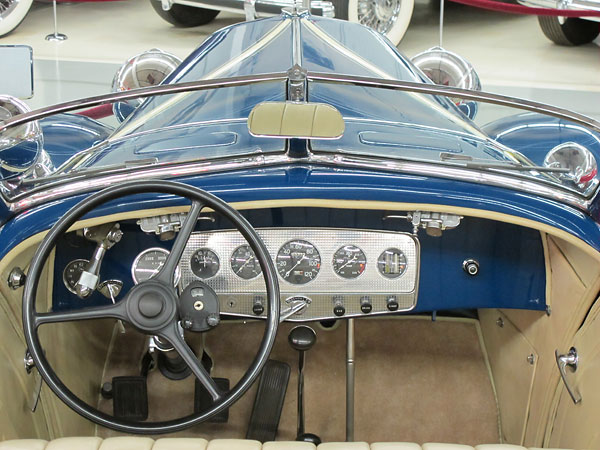
�
Six Speed Transmission?
�
An ordinary three-speed manual transmission was supplemented with an extraordinary Columbia
�
two-speed electric overdrive rear axle, operated via a switch on the steering column.
�
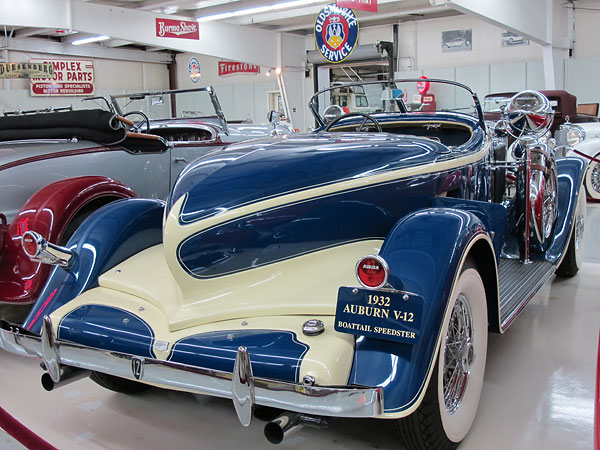
�
Auburn's Boat Tail
�
Auburn's Boattail Speedster didn't have either a trunk or rumble seat.
�
Instead, it had a small door for stashing a golf bag inside the tail.
�
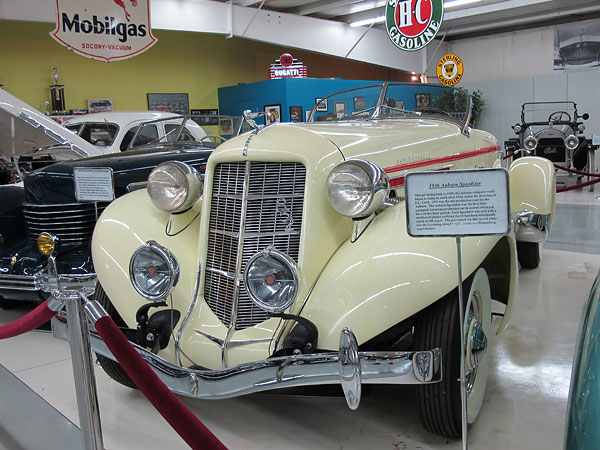
�
1936 Auburn Speedster
�
This Auburn Speedster features a Lycoming inline-8 engine with a Duesenberg supercharger.
�
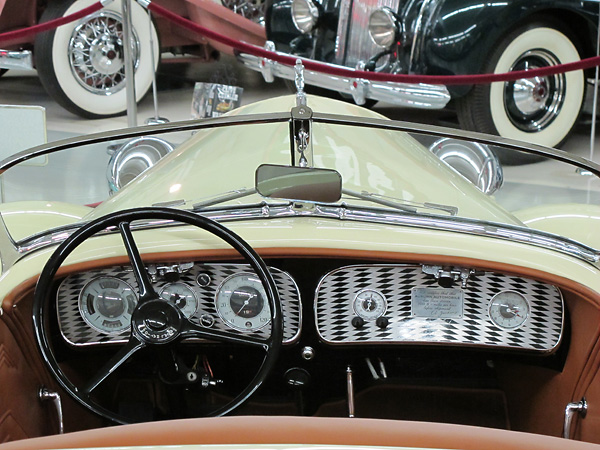
�
Stylish Dashboard
�
1936 was the final year of production for Auburn models.
�
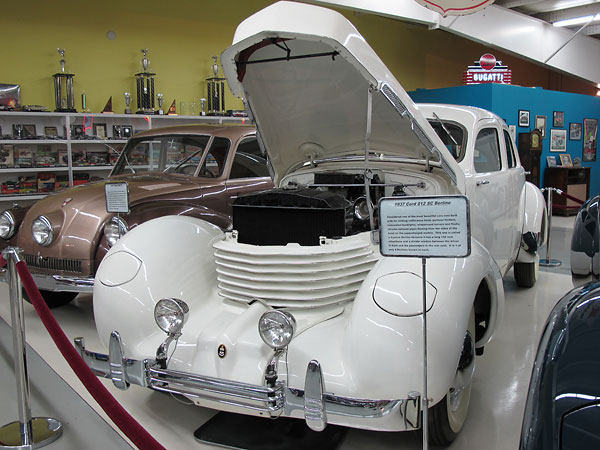
�
1937 Cord 812SC "Custom Berline"
�
The Cord brand, after being mothballed in 1932, was re-introduced in 1936 with the 810 series.
�
Styling certainly stood out from the crowd: coffin nose, pontoon fenders, wrap-around louvers,
�
flip-up headlights, etc. The Custom Berline variant cost $600 extra for a seven inch longer
�
wheelbase (132") and a glass divider between driver and passenger seats. Only four Cord 812SC
�
Custom Berlines are known to exist.
�
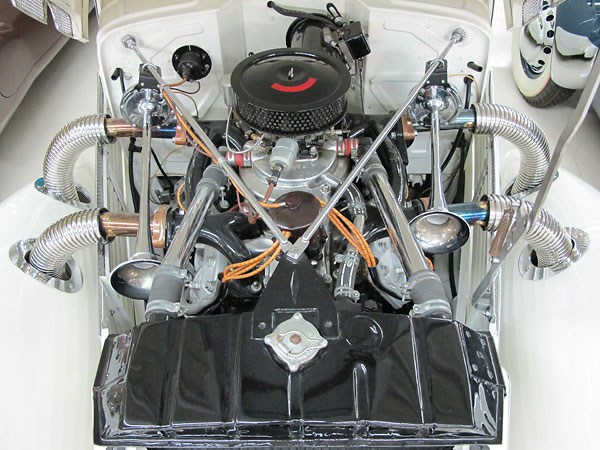
�
Schwitzer-Cummins Centrifugal Supercharger
�
288cid, 190hp, V8 engine. Four-speed preselector manual transmission. Front wheel drive.
�
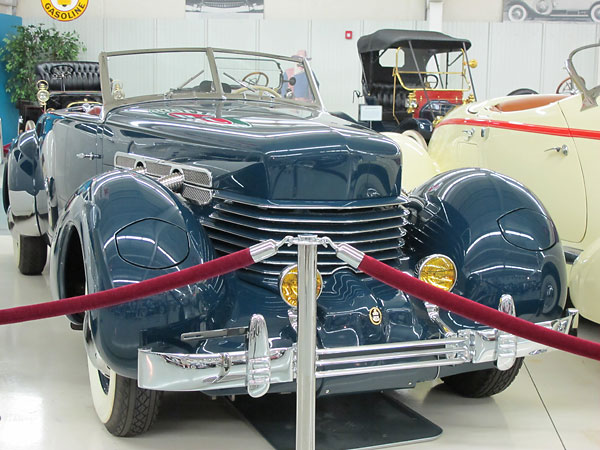
�
1937 Cord 812SC Convertible Coupe
�
This car is one of approximately 195 convertible coupes built. Only 64 of them were supercharged.
�
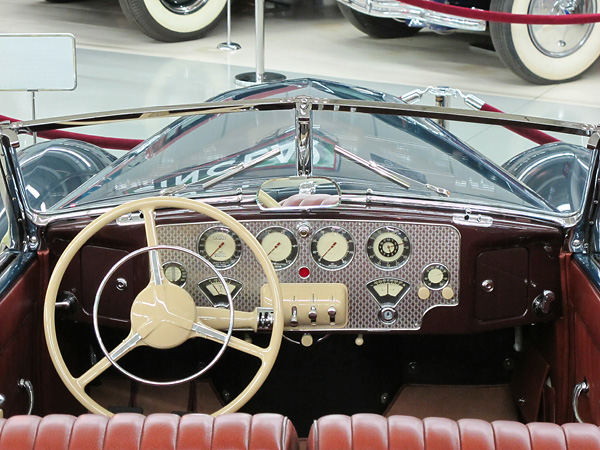
�
Cord production ended in 1937.
�
New York
��
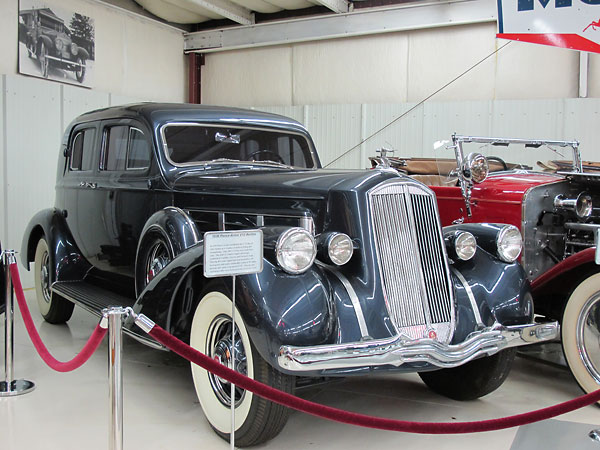
�
1936 Pierce-Arrow V12 Berline (Model 1602)
�
In 1928, Pierce-Arrow merged with a much larger and wealthier company. It was actually a welcome
�
takeover. Studebaker funded modernization of Pierce-Arrow's facilities and development of two new
�
engines: an inline-8 (circa 1929) and an eighty-degree V12 (circa 1932). When facing receivership
�
in 1933, Studebaker sold the Pierce-Arrow division to its management. Pierce would survive five
�
more years. Shown here: one of 206 1936 Pierce-Arrows built with 462cid V12 engines, rated 185hp.
�
Incidentally, Pierce-Arrow engineer Carl Voorhies invented self-adjusting, hydraulic tappets and they
�
were used in Pierce engines from 1932. What does Berline mean? Sedan. But in the context of
�
horse-drawn carriages, the term refers to a body suspended from frame rails via leather straps.
�
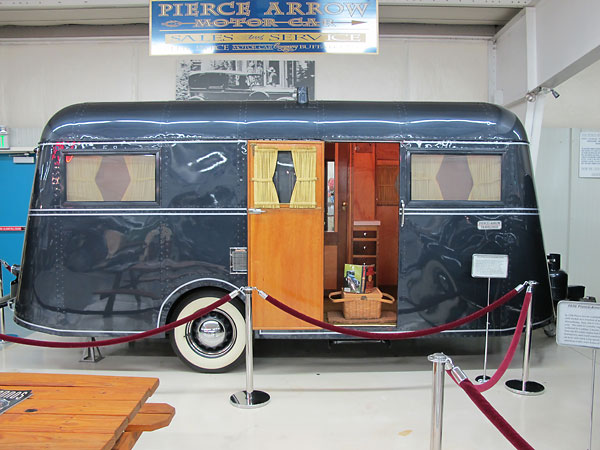
�
1937 Pierce-Arrow Travelodge (Model B)
�
Looking urgently for new ways to make money, Pierce-Arrow decided to build camper trailers.
�
This example is 16.5" long. It sleeps four. It has a fold-down dinette table, icebox, and heating
�
stove. And, it has a bathroom with sink and toilet! Pierce-Arrow would happily paint these to
�
order, or to match their cars. $845 new. Only 12 Pierce-Arrow Travelodges still exist.
�
Pennsylvania
��
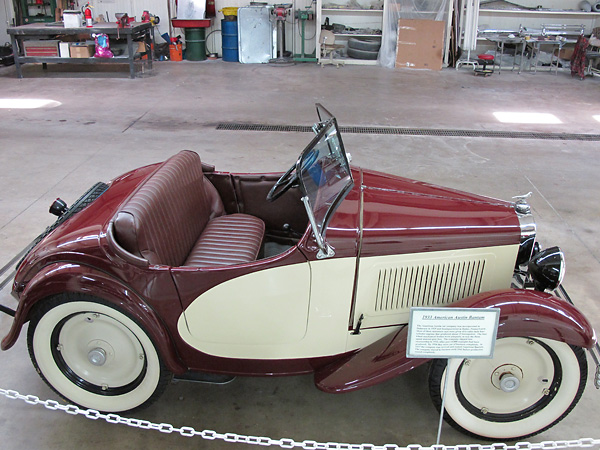
�
1933 American Austin Bantam
�
From founding in 1929 through bankruptcy in 1934, The American Austin Car Company was an
�
independent producer based in Butler Pennsylvania. Inspired by Austin Motor Company's
�
"Seven", they designed their own tiny "Bantam" car. Approximately 20,000 were built before
�
the market dried up. Bantams do feature many components licensed or imported from the British
�
Austin (e.g. 747cc engines), but their bodies were unique and always American made. Tiny and
�
lightweight, Bantam bodies were popular in the 1960s with hot-rodders and drag racers.
�
| �
Enjoying this article? Our magazine is funded through the generous support of readers like you! � To contribute to our operating budget, please click here and follow the instructions. � (Suggested contribution is twenty bucks per year. Feel free to give more!)� |
�
England
��
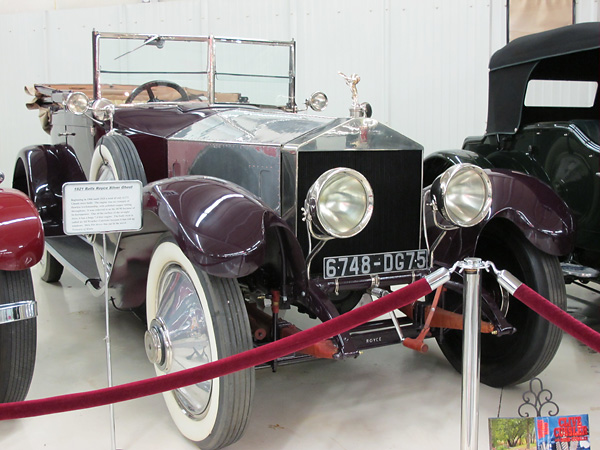
�
1921 Rolls Royce 40/50 h.p. (a.k.a. Silver Ghost)
�
The proper name for this chassis was "40/50 h.p.", though the name "Silver Ghost" came to widespread
�
use once Rolls Royce's "Phantom" was introduced in 1925. Silver Ghosts were so very exceptional at
�
introduction, few significant updates were needed over twenty years of production. Power ratings for
�
Rolls Royce's 7.4L inline-6 did gradually rise from 48bhp at 1250rpm to 80bhp at 2250 rpm. Electric
�
starters and headlights were provided from 1919. 7,874 Silver Ghosts were produced between 1906
�
and 1926: 6,173 in England plus 1,701 in Springfield, Massachusetts. This one is fitted with a
�
Park-Ward touring body.
�
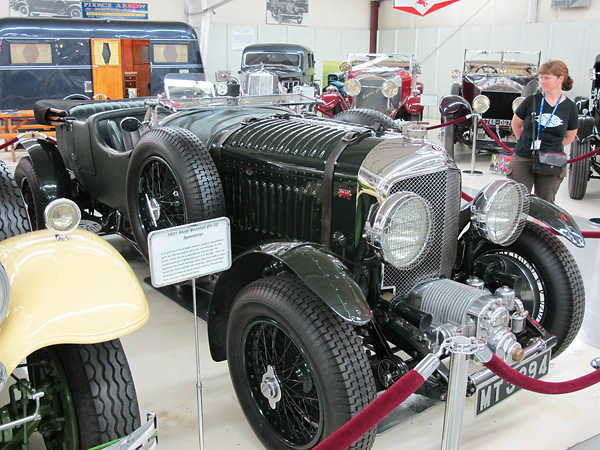
�
1929 Bentley 4.5L
�
Bentley's 4.5L engine was developed by dropping two cylinders from their successful but quite heavy
�
6.5L inline-6. Bentley built 270 cars around the 4.5L engine between 1927 and 1931. This particular
�
car was originally fitted with a Mulliner sedan body, but later a Vanden Plas Le Mans touring body was
�
substituted. Its 4.5L engine was updated with a high-lift camshaft, and a Bentley supercharger was
�
retrofitted. A previous owner vintage raced this car extensively and quite successfully in Europe.
�
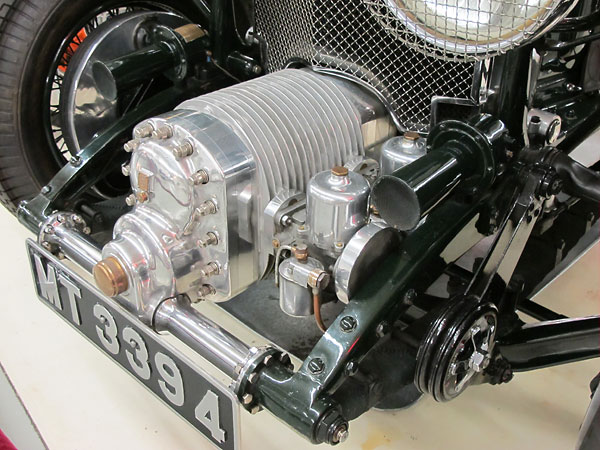
�
Birth of Birkin's "Blower Bentley"
�
Walter Owen Bentley was extremely skeptical about forced induction. "W.O." always preferred to increase
�
displacement. But Bentleys were raced at the very highest levels by wealthy independent customers. One
�
in particular, Sir Henry "Tim" Birkin, wouldn't take "no" for an answer. Birkin schemed to dominate The 24
�
Hours of Le Mans by supercharging five Bentley 4.5 racecars himself. Thus, the Bentley Blower was born.
�
Birkin's prototype captured other people's imagination. The factory relented. 55 Bentley Blowers were built.
�
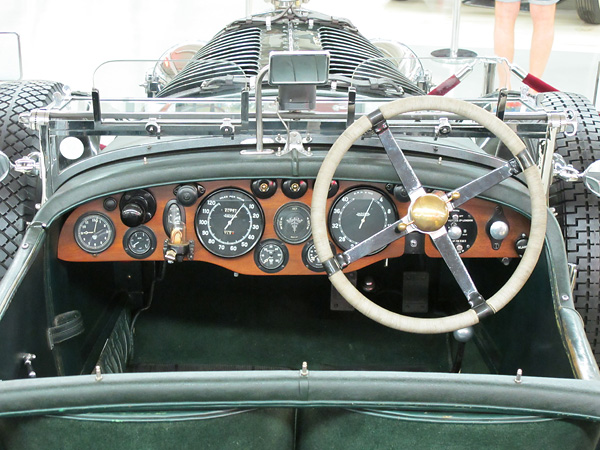
�
Blower Bentleys in Competition
�
Ironically, Birkin's Blower Bentley failed badly at Le Mans. In the 1930 race, six-cylinder Bentleys
�
finished first and second place while two Blower Bentleys (including one driven by Birkin) failed to
�
finish. However, Birkin did log that race's quickest lap. Blower Bentleys also set several speed
�
records. Famously, a Blower Bentley circled Brooklands at 138mph in 1932.
�
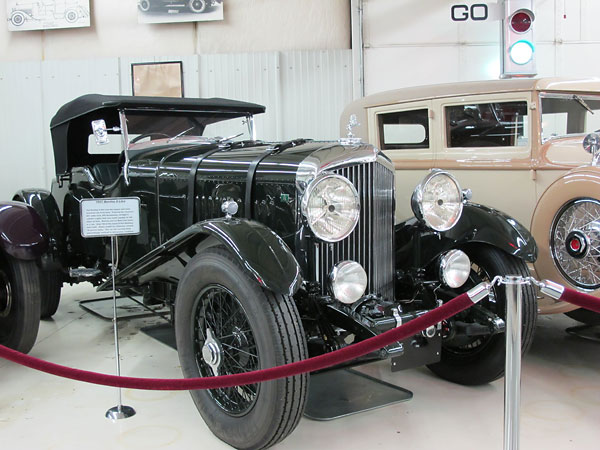
�
1931 Bentley 8 Litre
�
Mr. Cussler's collection includes several cars that were the final and best efforts of great manufacturers.
�
Of these, the 8 Litre Bentley is exceptional. Even with limousine coachwork and seven passengers aboard,
�
these cars would pull like a train to over 100mph. In acceleration and maximum speed, the grand Bentleys
�
outperformed Rolls Royce's "Phantom II" and Mercedes' supercharged "770", yet did so with remarkable
�
smoothness and a modest exhaust tone. Contemporary magazines universally praised this biggest Bentley
�
but there weren't enough buyers to recoup development costs. Only 100 were built. Of the 78 which survive,
�
many have been substantially altered: original buyers preferred enclosed body styles and the longest
�
optional wheelbase whereas modern collectors prefer lightweight open bodies and shorter wheelbases.
�
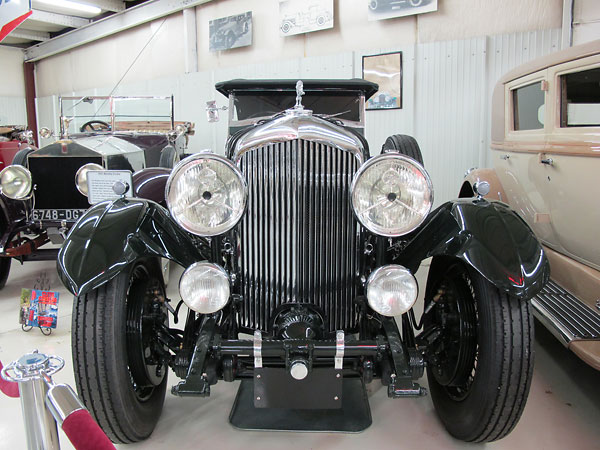
�
The Fate of Bentley Motors Limited
�
Bentley Motors Limited slipped into receivership on July 10, 1931 after failing to make mortgage payments.
�
At the time, Bentley management was confident aviation engine manufacturer D. Napier & Son Limited would
�
be their white knight, but it wasn't Bentley's decision to make. Rolls Royce acquired Bentley through a sealed
�
bid auction. Rolls Royce management recognized the value of Bentley's trademark, and for the next
�
seventy years Bentley cars were badge-engineered variants of Rolls Royce models.
�
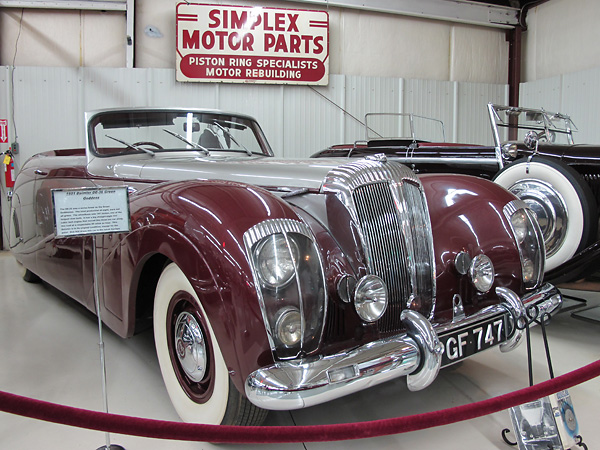
�
1951 Daimler DE36 "Green Goddess" (chassis number 51745)
�
From 1900 through 1950, Britain's Daimler Company Limited supplied nearly every car used by the royal family.
�
The firm's direction began to change with introduction of the DE36 chassis at the Earl's Court Motor Show in 1948.
�
A magnificent jade green convertible stole attention away from Daimler's usual stodgy limousines. This original
�
"Green Goddess" featured streamlined bodywork by Hooper. Eight cars of this type were completed, and they're
�
collectively called Green Goddesses though they were painted various colors. In 1949, Daimler's Managing Director
�
Bernard Docker married socialite Norah Lady Collins. She believed an extravagant lifestyle would lift Daimler's
�
fortunes. Lady Docker's lifestyle and the show cars she inspired kept Daimler in British tabloids, even as Daimler
�
drifted from their traditional niche. The Docker's were forced out in 1956. Jaguar absorbed Daimler in 1960.
�
France, Italy, and... Czechoslovakia?
��
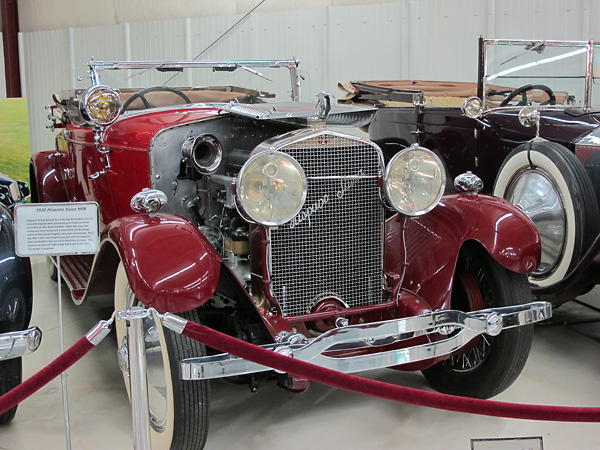
�
1926 Hispano-Suiza H6B
�
Swiss engineer Marc Birkigt designed much of this car and earlier versions of it were built in Spain, but
�
Hispano-Suiza H6Bs are French automobiles. Hispano-Suiza engines feature steel sleeved, cast aluminum
�
engine blocks and overhead camshafts. They displace 6597cc, and have a reputation for smoothness and
�
excellent torque output. The chassis features servo-assisted aluminum drum brakes on all four wheels.
�
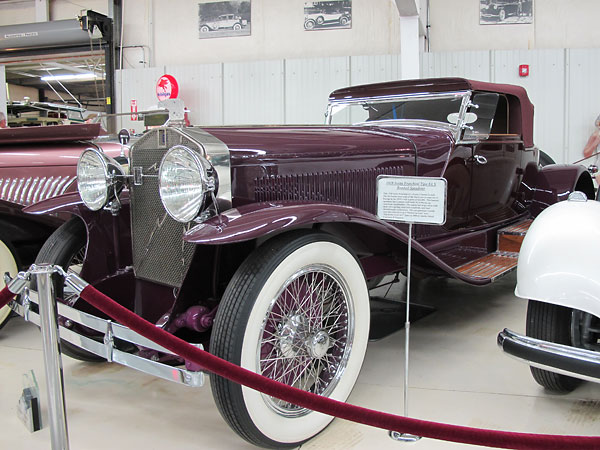
�
1928 Isotta Fraschini Tipo 8A S Boattail Speedster
�
Cesare Isotta and Vincenzo Fraschini began producing cars in 1902 and their company continued until
�
World War II when production shifted to military aviation and marine engine parts. The boattail speedster
�
bodywork on this example is rare. Two bodies of this type were produced by LeBaron in U.S.A.
�
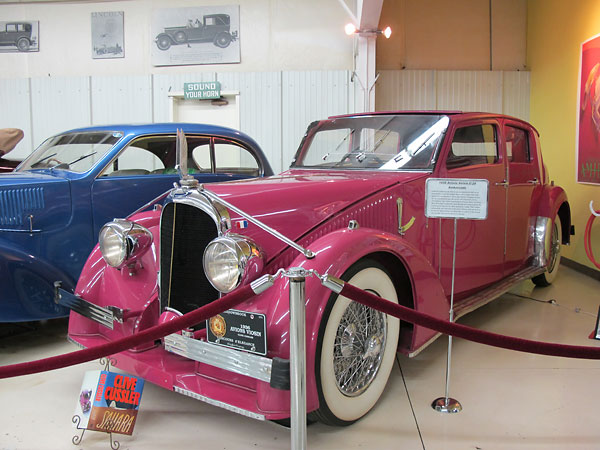
�
1936 Avions Voisin C28 Ambassade
�
The styling and color of this car put me off. I can't bring myself to research or write about it. Sorry.
�
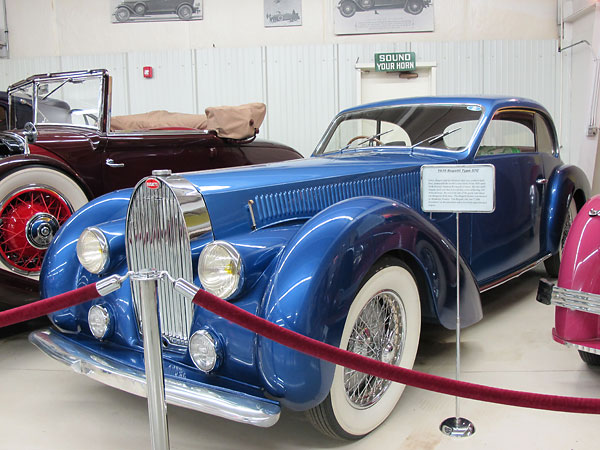
�
1939 Bugatti Type 57C
�
Ettore Bugatti racecars dominated racing on the European continent from 1925 through 1938.
�
The company also built luxurious cars at its factory in Molsheim France.
�
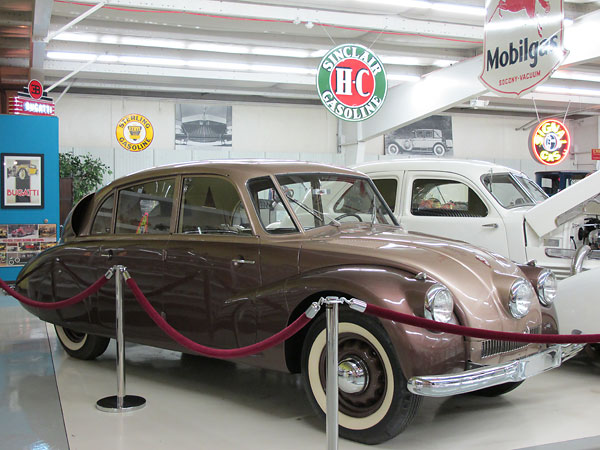
�
1947 Tatra Type 87
�
This Tatra Type 87 is probably the most esoteric car in Cussler's collection: three headlights, three-pane
�
windshield, suicide front doors, a shark fin for aerodynamic stability, air scoops on the side for engine
�
cooling, windows into the engine compartment from both the cabin and the exterior, wheel spats, and
�
other futuristic features that might have excited Buck Rogers fans... but these cars were mostly built
�
for the German market. On the technical side: an air cooled, overhead cam, ninety degree, V8 engine
�
which displaces 180cid and delivers about 80 horsepower. Small, but enough to propel a Type 87 to
�
100mph on the autobahn. Initially introduced in 1936, production continued after WW2 and ultimately
�
3056 Type 87s were built. Arguably the world's third oldest automaker, Tatra phased out passenger
�
car production in the late 1990s but stills produces commercial vehicles.
�
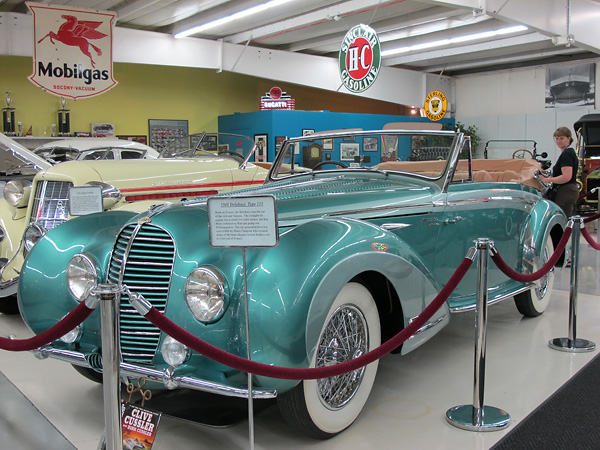
�
1948 Delahaye Type 135
�
Delahaye started producing cars around 1896, but really came into their own with the low-slung Type 135
�
chassis, circa 1935. These came equipped with excellent inline six-cylinder engines in 3.2L and (later) 3.5L
�
sizes. Some were successfully raced. Mainly, the 135 proved a blank canvas for high end French car stylists.
�
This particular Delahaye is easily one of the loveliest cars in the Cussler collection: it features a custom body
�
by Henri Chapron. Delahaye production resumed after WW2. Approximately two thousand Type 135 chassis
�
were built before the Delahaye firm closed in 1954.
�
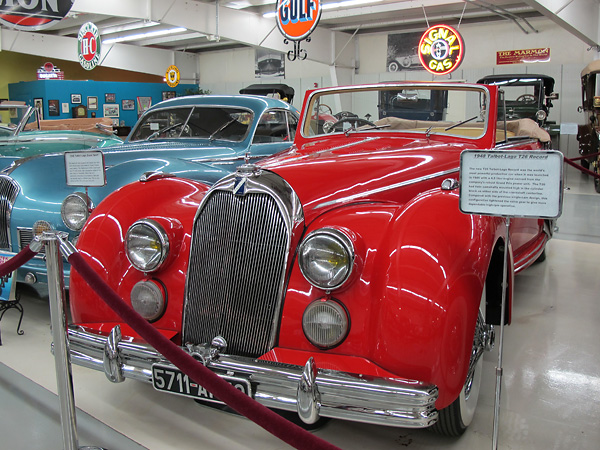
�
1948 Talbot-Lago Record T26
�
In 1935, Antonio Lago purchased the French assets of the Sunbeam-Talbot-Darracq company and reorganized them
�
as "Automobiles Talbot-Darracq S.A.". After the merger, Lago's cars were marketed under the brand "Talbot-Lago".
�
From 1946, his top-of-the-line engines were enlarged to 4.5L and featured hemispherical combustion chambers and
�
dual camshafts acting through pushrods. Relatively low rotating mass provided good high RPM performance. The
�
Record model was an executive class car offered with four or two doors and with either sedan and coupe versions.
�
Bespoke bodies could also be arranged, though the market for coachbuilt cars was now unmistakably declining.
�
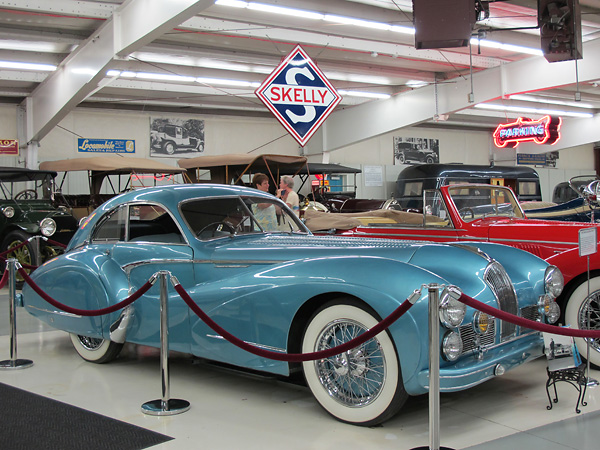
�
1948 Talbot-Lago Grand Sport
�
Through the 1940s, most Talbot-Lago cars came with Talbot's own steel bodies. From October 1948, Talbot-Lago
�
offered a short-wheelbase variant of their T26 chassis with a specially tuned version of the 4.5L six-cylinder.
�
Only twelve examples of this new short-wheelbase "Grand Sport" were built in 1948, and all twelve were
�
despatched to coachbuilders. Jacques Saoutchik of Paris built this extraordinarily glamorous example.
�
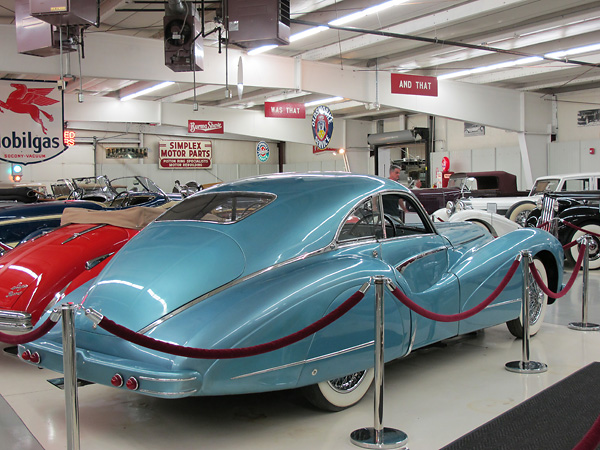
�
Amazingly, this particular car was literally a barn find. It had been used as a chicken coup for years!
�
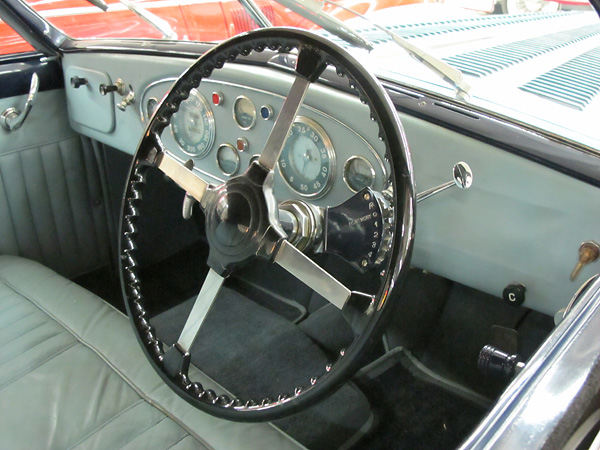
�
Wilson pre-selector gearboxes were a popular option on Talbot-Lagos of this era.
�
| �
Enjoying this article? Our magazine is funded through the generous support of readers like you! � To contribute to our operating budget, please click here and follow the instructions. � (Suggested contribution is twenty bucks per year. Feel free to give more!)� |
The Front Room
��
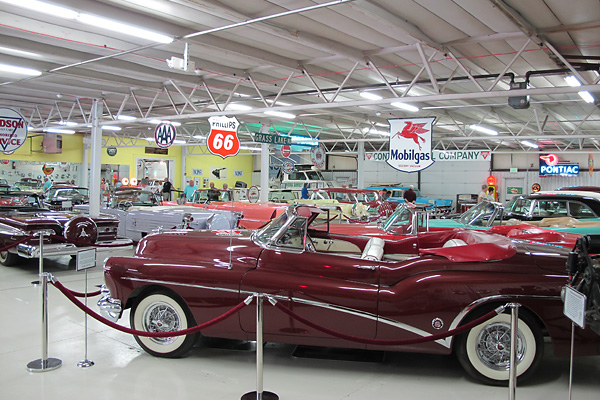
�
The front room of the Cussler Museum almost exclusively features convertible variants of familiar
�
mass-produced American automobiles. A Cadillac Eldorado Biarritz is lovely and it's impressive
�
to see two of them parked side-by-side, but I'd recommend saving them for your second visit.
�
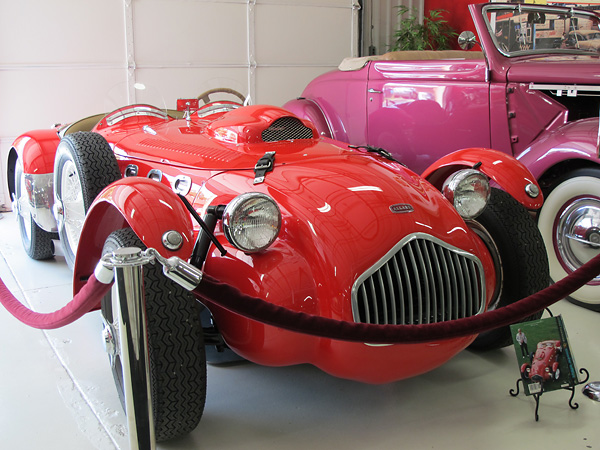
�
Closest to the door: 1952 Allard J2X
�
With a big American engine shoehorned into a lightweight British chassis, an Allard J2X parked just inside
�
the door is sure to interest BritishV8 enthusiasts. Though apparantly featured in a Cussler novel, I couldn't
�
help thinking the J2X is out of place in his museum; it belongs on track or in a paddock with other racecars.
�
And these beasts look a whole lot better less restored, with some patina. I hope these last notes aren't too
�
discordant: I enjoyed my visit to The Cussler Museum immensely and I certainly look forward to returning.
�
(Did you hope to read more about Allards? You might enjoy this.)
�
�
�
Disclaimer: This page was researched and written by Curtis Jacobson.�
Views expressed are those of the author, and are provided without warrantee or guarantee.�
Apply at your own risk.�
�
All photos by Curtis Jacobson for BritishV8 Magazine. All rights reserved.�
�
�
If you liked this article, you might also enjoy:
�
• BritishV8 2013: Tour of Speedway Motors' Museum of American Speed
�
• BritishV8's Tour of Morgan Motor Company's Factory
�
• BritishV8 2012: Tour of Hatfield Restorations
�
• BritishV8 2012: Tour of the Texas State Railway Maintenance Facility
�
• BritishV8 2010: Tour of The Indy 500 Hall of Fame Museum
�
• BritishV8 2010: Tour of Mark Scott's Prototype Development Shop
�
• BritishV8's Tour of The MG Owners' Club in Cambridge
�
• BritishV8's Tour of British Motor Heritage
�
�

 �
�
 �
�
